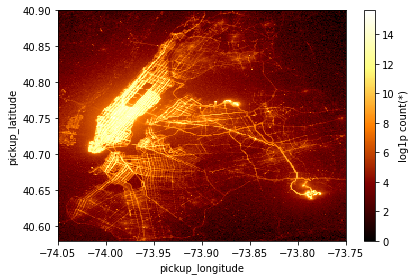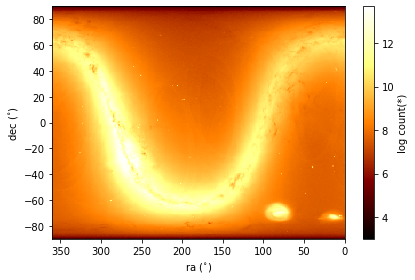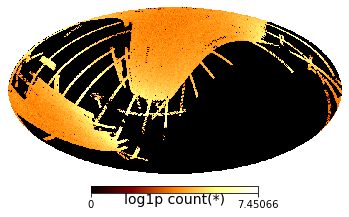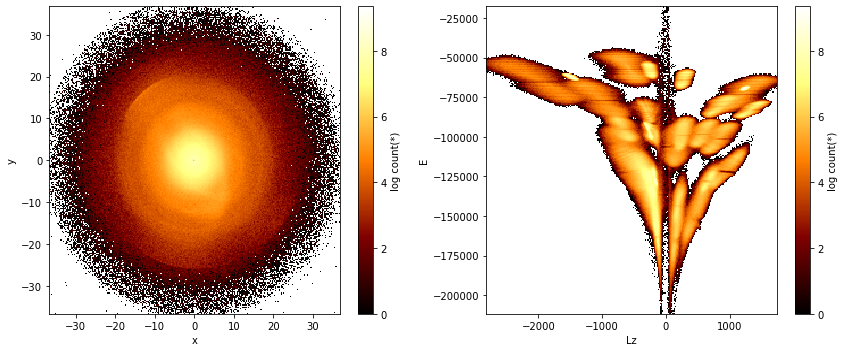Datasets to download¶
Here we list a few datasets that might be interesting to explore with vaex.
New York taxi dataset¶
The very well known dataset containing trip infromation from the iconic Yellow Taxi company in NYC. The raw data is curated by the Taxi & Limousine Commission (TLC).
See for instance Analyzing 1.1 Billion NYC Taxi and Uber Trips, with a Vengeance for some ideas.
One can also stream the data directly from S3. Only the data that is necessary will be streamed, and it will cached locally:
import vaex
df = vaex.open('s3://vaex/taxi/yellow_taxi_2015_f32s.hdf5?anon=true')
[1]:
import vaex
import warnings; warnings.filterwarnings("ignore")
df = vaex.open('/data/yellow_taxi_2009_2015_f32.hdf5')
print(f'number of rows: {df.shape[0]:,}')
print(f'number of columns: {df.shape[1]}')
long_min = -74.05
long_max = -73.75
lat_min = 40.58
lat_max = 40.90
df.plot(df.pickup_longitude, df.pickup_latitude, f="log1p", limits=[[-74.05, -73.75], [40.58, 40.90]], show=True);
number of rows: 1,173,057,927
number of columns: 18

Gaia - European Space Agency¶
Gaia is an ambitious mission to chart a three-dimensional map of our Galaxy, the Milky Way, in the process revealing the composition, formation and evolution of the Galaxy.
See the Gaia Science Homepage for details, and you may want to try the Gaia Archive for ADQL (SQL like) queries.
[2]:
df = vaex.open('/data/gaia-dr2-sort-by-source_id.hdf5')
print(f'number of rows: {df.shape[0]:,}')
print(f'number of columns: {df.shape[1]}')
df.plot("ra", "dec", f="log", limits=[[360, 0], [-90, 90]], show=True);
number of rows: 1,692,919,135
number of columns: 94

U.S. Airline Dataset¶
This dataset contains information on flights within the United States between 1988 and 2018. The original data can be downloaded from United States Department of Transportation.
One can also stream it from S3:
import vaex
df = vaex.open('s3://vaex/airline/us_airline_data_1988_2018.hdf5?anon=true')
[3]:
df = vaex.open('/data/airline/us_airline_data_1988_2018.hd5')
print(f'number of rows: {df.shape[0]:,}')
print(f'number of columns: {df.shape[1]}')
df.head(5)
number of rows: 183,821,926
number of columns: 29
[3]:
| # | Year | Month | DayOfMonth | DayOfWeek | UniqueCarrier | TailNum | FlightNum | Origin | Dest | CRSDepTime | DepTime | DepDelay | TaxiOut | TaxiIn | CRSArrTime | ArrTime | ArrDelay | Cancelled | CancellationCode | Diverted | CRSElapsedTime | ActualElapsedTime | AirTime | Distance | CarrierDelay | WeatherDelay | NASDelay | SecurityDelay | LateAircraftDelay |
|---|---|---|---|---|---|---|---|---|---|---|---|---|---|---|---|---|---|---|---|---|---|---|---|---|---|---|---|---|---|
| 0 | 1988 | 1 | 8 | 5 | PI | None | 930 | BGM | ITH | 1525 | 1532 | 7 | -- | -- | 1545 | 1555 | 10 | 0 | None | 0 | 20 | 23 | -- | 32 | -- | -- | -- | -- | -- |
| 1 | 1988 | 1 | 9 | 6 | PI | None | 930 | BGM | ITH | 1525 | 1522 | -3 | -- | -- | 1545 | 1535 | -10 | 0 | None | 0 | 20 | 13 | -- | 32 | -- | -- | -- | -- | -- |
| 2 | 1988 | 1 | 10 | 7 | PI | None | 930 | BGM | ITH | 1525 | 1522 | -3 | -- | -- | 1545 | 1534 | -11 | 0 | None | 0 | 20 | 12 | -- | 32 | -- | -- | -- | -- | -- |
| 3 | 1988 | 1 | 11 | 1 | PI | None | 930 | BGM | ITH | 1525 | -- | -- | -- | -- | 1545 | -- | -- | 1 | None | 0 | 20 | -- | -- | 32 | -- | -- | -- | -- | -- |
| 4 | 1988 | 1 | 12 | 2 | PI | None | 930 | BGM | ITH | 1525 | 1524 | -1 | -- | -- | 1545 | 1540 | -5 | 0 | None | 0 | 20 | 16 | -- | 32 | -- | -- | -- | -- | -- |
Sloan Digital Sky Survey (SDSS)¶
The data is public and can be queried from the SDSS archive. The original query at SDSS archive was (although split in small parts):
SELECT ra, dec, g, r from PhotoObjAll WHERE type = 6 and clean = 1 and r>=10.0 and r<23.5;
[4]:
df = vaex.open('/data/sdss/sdss-clean-stars-dered.hdf5')
print(f'number of rows: {df.shape[0]:,}')
print(f'number of columns: {df.shape[1]}')
df.healpix_plot(df.healpix9, show=True, f="log1p", healpix_max_level=9, healpix_level=9,
healpix_input='galactic', healpix_output='galactic', rotation=(0,45)
)
number of rows: 132,447,497
number of columns: 21

Helmi & de Zeeuw 2000¶
Result of an N-body simulation of the accretion of 33 satellite galaxies into a Milky Way dark matter halo. * 3 million rows - 252MB
[5]:
df = vaex.datasets.helmi_de_zeeuw.fetch() # this will download it on the fly
print(f'number of rows: {df.shape[0]:,}')
print(f'number of columns: {df.shape[1]}')
df.plot([["x", "y"], ["Lz", "E"]], f="log", figsize=(12,5), show=True, limits='99.99%');
number of rows: 3,300,000
number of columns: 11
